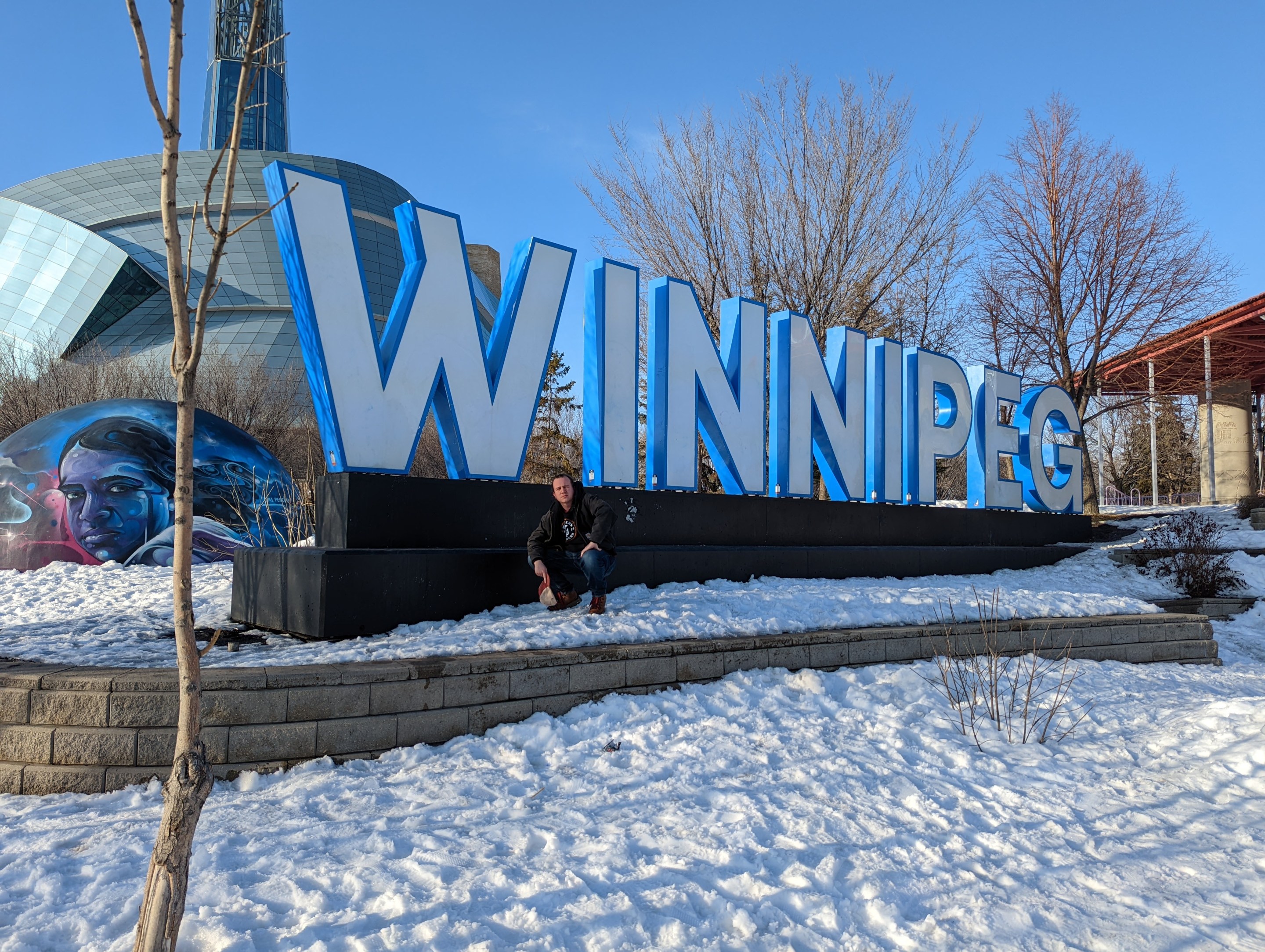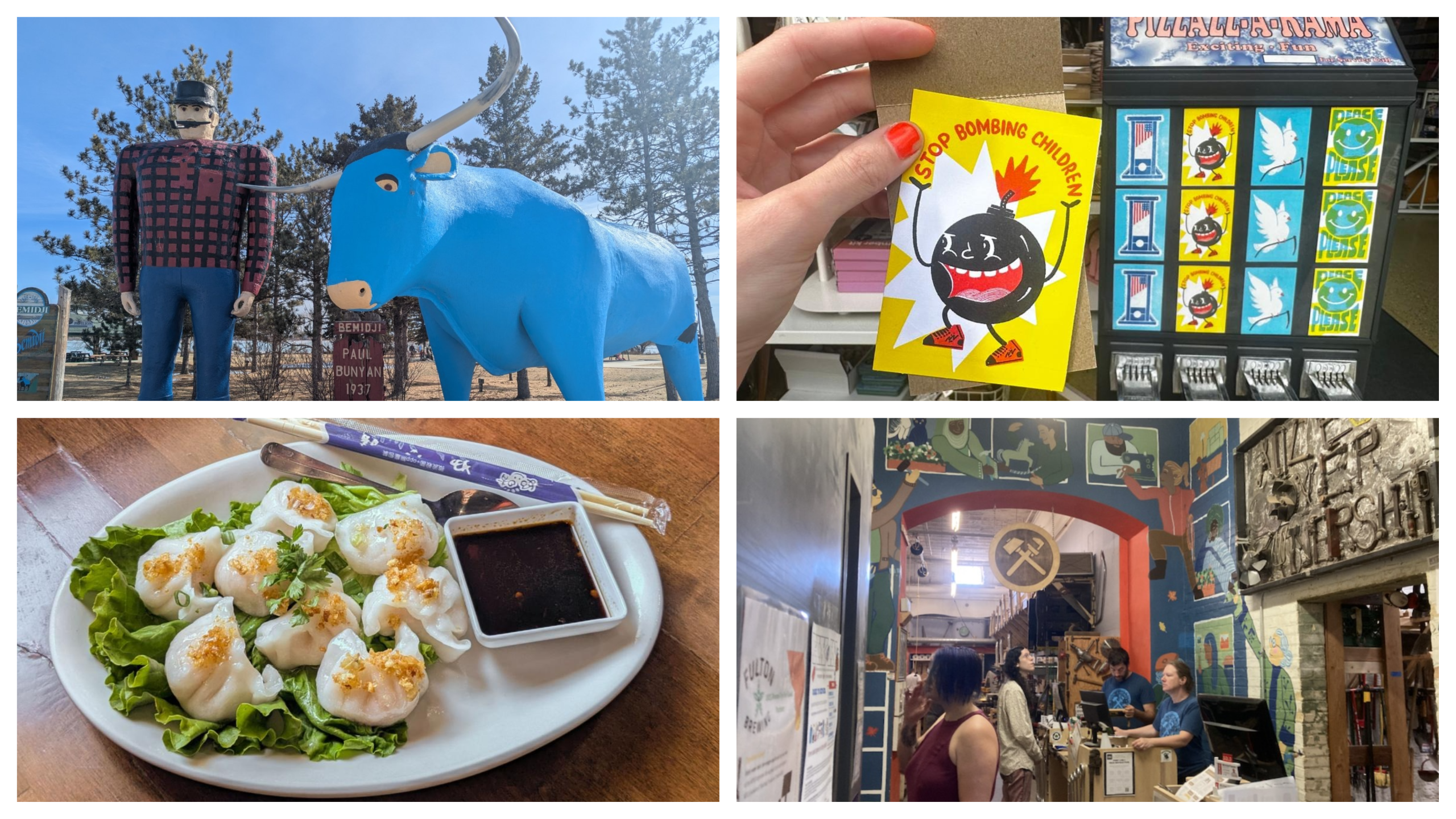On an unseasonably warm Friday this March, I approached the Canadian border crossing. “You guys going fishing?” the I-29 border guard asked, eying me and my travel companion.
I replied with the deferential tone I reserve for avoiding “random” security screenings. “No, sir. Going to Winnipeg.”
“Winnipeg?” he asked, skepticism in his voice. “…Why?”
“Yes sir, Winnipeg,” I replied. “For fun.”
Canada has roughly 38 million residents and, in a classic show of Canadian hospitality, they’ve located most of them near their southern border, all the better to welcome visiting Americans. Winnipeg, at 800,000 residents and a drivable-by-Midwest-standards seven and a half hours, is the closest major Canadian city to the Twin Cities.
That’s awfully close for a city I know nothing about! One particularly brutal January day, I tweeted my first of many Winnipeg thoughts. “The idea of Winnipeg freaks me out,” I wrote. “Seven hours north of the cities, they plopped down a metro of 800k people and we just don't talk about it, like it's fucking Craster's Keep.”
The tweet struck a chord on Twin Cities Twitter, with eager Winnipeg fans and haters alike sharing their associations with the Manitoba capital. We share some common Winnipegian touchstones: Guy Maddin’s fantastical semi-documentary My Winnipeg; the scathing Weakerthans song “One Great City!”; and the fact that it’s a legal drinking destination for the 18 to 20 crowd in North Dakota. Other commenters remarked that they’d never even thought about its existence and were shocked to learn how close it really was.
Clearly, I wasn’t alone in my curiosity about our northern neighbors, and I knew just the Twin Cities independent journalism outfit to convert a Twitter gag into a bonafide piece of citizen journalism.
With my keen nose for Twitter infamy and refusal to back down from a bit, I was soon in touch with the kind people at Tourism Winnipeg, who set up a weekend itinerary for a visit and very generously subsidized my exploration of their city. After months of research, careful planning, and some additional Winnipeg meme-making, I’m proud to bring you the very first Racket Reader Investigation: “What’s the deal with Winnipeg?”
Founded in 1873, Winnipeg sits on the confluence of the Assiniboine and Red Rivers, on a site that served as a trading center for Indigenous people long before European colonization. To hear our tour guide Don tell it, the city has spent the last 100 years on the ropes. An economic and population boom saw Winnipeg quadruple in size between 1900 and 1920, and the city became the third most populous in Canada. Wide boulevards were laid out from an elegant train station, and a provincial capitol building suitable for a great city of the plains was constructed with all the attendant neo-classical flourishes. A 1919 general strike with subsequent state repression made Winnipeg the beating heart of class warfare 15 years before Minneapolis would don that mantle.
The good times can’t last forever, though. Due to a long series of crises ranging from the completion of the Panama Canal to the humiliating relocation of a hockey franchise to the southern U.S. (an ignominy we share), the city never reached the potential envisioned a century ago. Growth slowed, economic boom turned to bust, and the confidence of the city styled as “The Gateway to The West” was irrevocably shaken. Like so many familiar landscapes in America’s Rust Belt cities, streetcars gave way to asphalt. Jiffy Lubes and parking lots sprouted from spores in the shadow of gorgeous Chicago-style buildings throughout downtown districts made for a metropolis that never quite arrived.
Winnipeg is sorry. They’re sorry they never fulfilled their destiny to be the great city of the plains. They’re sorry about spring, which grants the intrepid visitor neither iconic winter activities like ice skating on frozen rivers and warming up in an artfully designed tent over drinks, nor the folk festivals and patios of summer. They’re sorry the border guard was suspicious of your vacation destination, and they’re sorry about that embarrassing thing with the truckers.
Ignore their apologies—or at least let them blend into a white noise of Canadian modesty. If my weekend up north was any indication, Winnipeggers (I swear, this is what they call themselves) have plenty to pride themselves on.
The Forks area, named after the forking of the Assiniboine and Red Rivers that form its boundaries, is a former rail yard redeveloped into an entertainment and tourist district. There are hints of Duluth’s Canal Park in the juxtaposition of decommissioned industrial freight and boutique shopping, but The Forks struck me as a place more readily visited by the locals, not just tourists. A converted horse stable now serves as the home of The Forks market, with over a dozen local restaurants in the recently popular food hall style found locally at Keg & Case or Malcolm Yards.

Locals pride themselves on the 10 kilometers of groomed ice skating trails along both rivers, which can be easily accessed from The Forks, including skating rentals for the curious newbie and warming stations along the route. I was relieved to find that warm weather had forced them to close a few days prior to my visit, as both my travel companion and our hosts were excited to see me take my first crack at ice skating in over a decade. I suppose bodily injury just doesn’t have the same stigma when you have access to socialized healthcare.
At the edge of The Forks lies the visually striking Canadian Museum for Human Rights, which, over its seven floors, explores the history of human rights, both the struggles for and the greatest violations thereof. It was a frequent recommendation of the Twitter crowd, and a must see from the tourism bureau.
The interior is striking in its magnitude, looking more like a Denis Villeneuve set than a classic gallery, with 800 meters of alabaster walkways slowly climbing through the exhibits to the final attraction—an observation deck providing a glimpse of melting snow as far as the eye can see. The slow ascent through the museum is designed to bring you out of the darkness of the bottom levels and closer to the natural light streaming in through windows on the higher levels, a bold metaphor for a city that receives as little as 8 hours and 16 minutes of daylight in the depths of winter (30 minutes shorter than our solstice in the Twin Cities). The exhibits are powerful, and I would caution the prospective visitor to plan carefully about where in their vacation they feel best prepared to grapple with stories of war and genocide.
Both Manitoba and Minnesota sit upon ancestral Dakota and Anishinaabe land, and while it’s neither my place nor my intention to hand out participation trophies to settler colonial states for acknowledging their history (as opposed to say, supporting land reclamation projects), the role of Native people in the history and identity of Winnipeg seemed more immediately visible than in the Twin Cities.
Since the 17th century, Canada, and Manitoba specifically, has been home to the Métis—the offspring of Indigenous First Nations people and the predominantly French fur trappers and traders. Over time, the Métis developed distinct communities and culture, and at the time of Manitoba’s admission into Canada, Winnipeg was led by a Métis provisional government. The city’s celebrated founder, Louis Riel, led the Métis in rebellion against Canadian encroachment multiple times throughout his life, a habit for which he was eventually executed.
Native people, including the Métis, today make up over 10% of Winnipeg’s population, and their cultural heritage was explored in every museum I visited. The Museum for Human Rights had an unflinching exhibit on Residential Schools and art produced by their survivors. The Winnipeg Art Gallery opened the Qaumajuq Inuit Art Center in 2021, which features thousands of works from contemporary Inuit artists, including breathtaking stone carvings depicting arctic life.
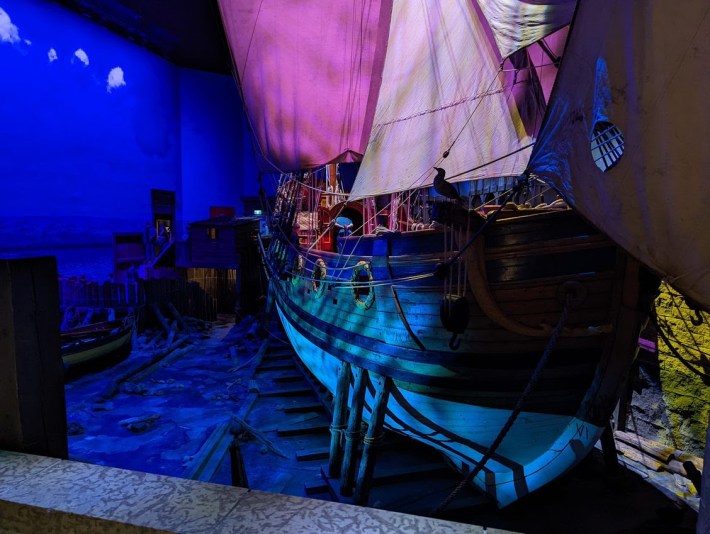
The Manitoba Museum explores both the Indigenous and colonial roots of the province, with exhibits on human heritage, the environment, and the interactions therein. In addition to an impressive artifact collection, a planetarium, and unsettling wax sculptures depicting both First Nations and settler life, the museum features a full sized replica of the HBC Nonsuch—the 54-foot ketch ship whose exploratory mission founded the Hudson Bay Company. The replica ship sailed from England in 1970 to commemorate the 350th anniversary of the expedition and was so large that the gallery itself was built around the vessel. The effect of stepping onto a 17th-century ship indoors kicked off an unexpected bit of The Goonies nostalgia on a weekend that I hoped would achieve Strange Brew nostalgia instead.
Winnipeg is actually quite close to the geographic center of North America, located a few hours southwest in Rugby, North Dakota. Once you get to the border, Winnipeg is only an 80-minute jaunt up the highway. The prudent traveler can avoid paying Canadian gas prices, or having to learn what a liter is, by filling up at the last fuel station in the States and hitting it on the way back through. Yet despite its proximity to the southern border, the city clearly celebrates its connections to the arctic, and given the lack of major settlements to its north, few are likely to contest the title.
In its defense, much of the economic viability of the young Winnipeg was its access to shipping routes both through the actually-quite-far-north Hudson Bay and a plucky upstart city down south called St. Paul, Minnesota. Winnipeg is a common way-station for travelers on their way to distant Churchill, Manitoba, seeking a glimpse at the northern lights or polar bears, presumably so they can tell their grandkids what they looked like. Churchill, 1,000 miles north of Winnipeg, is the same distance from the city as Omaha, Nebraska, and is not connected via a road network. Congratulations urbanists!
Since I had no appetite for a three-day train ride or a prohibitively expensive flight, I chose instead to take in the arctic experience at Winnipeg’s Assiniboine Park Zoo and their “Journey to Churchill” exhibit. Instead of a three-day train ride, this Journey to Churchill featured polar bears, seals, and a tasteful selection of impossible-to-see white animals well adapted to their snowy climate. They promised that an arctic fox was in there somewhere!
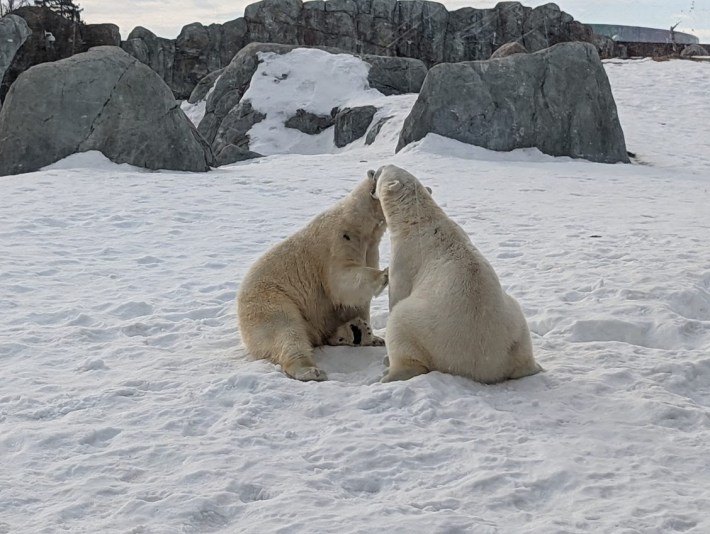
There’s much that makes Winnipeg unique, but there’s also plenty that makes it a pleasant destination in the same way that most any American city would be. The Exchange District is a charming and pedestrian-friendly neighborhood packed with bars, hip restaurants, and boutique shops. Like an increasing number of more civilized states, Manitoba has recreational pot, and the punny signs of cannabis shops are hard to miss around the city.
The dining options were quite expansive and diverse, with many world cuisines represented around the city. Fans of experimental dining will be happy to know Winnipeg has restaurants with names like “one sixteen” where all prices are listed in integer formats and small shareable plates are the rule. The meal was delicious, mind you, but I fear that the North Loop may have broken containment and spread across the border.
If you find yourself still hungry after you’ve exhausted your budget on small plates, poutine is a ubiquitous presence on most bar menus, and Smoke’s Poutinerie served a wide selection of fusion poutines like Buffalo Chicken and Korean Beef sure to make a proper Montrealer scream, “Sacré bleu!” The restaurant had all the ambiance of a Topper’s Pizza, but if you’re sober enough to worry about ambiance, you’re probably in the wrong place.
I visited three breweries over my two days, and while nothing competed with the top tier of Twin Cities breweries, they were all enjoyable. I was pleased to see Belgians and sours appear regularly on tap lists alongside the hopbombs and blonde ales. Little Brown Jug brewing in the Exchange District was suspiciously vacant on a Friday evening, and I was relieved to find that wasn’t due to the beer. “I think a lot of folks in Winnipeg don’t think about hanging out at breweries,” explained the beertender, much to the horror of the two northeast Minneapolis residents.
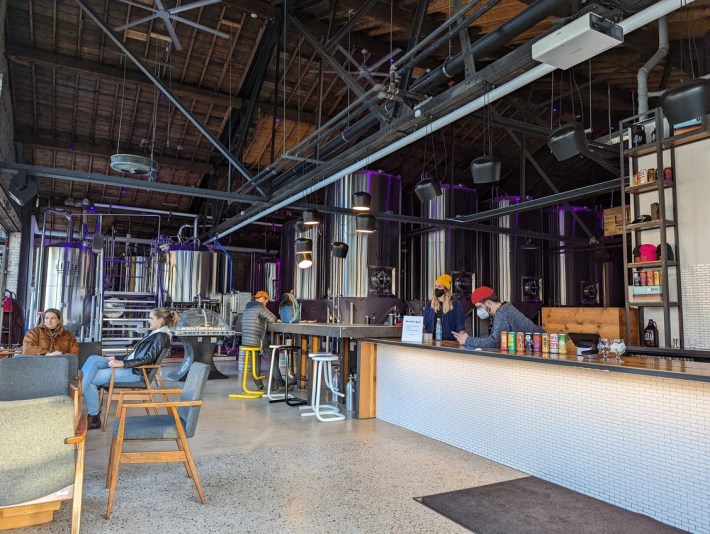
With several new breweries set to open soon, and local tap lists dominated by craft beer, the beer scene seems to be getting stronger. Yellow beer drinkers should be prepared to order their Budweiser off the import list alongside Corona. For the liquor inclined, bartenders were happy to recommend a number of unfamiliar Canadian whiskeys. I, in a moment of cultural-exchange fueled stupidity, asked to try a Paralyzer—a Canadian cocktail staple much like a White Russian, but with a large splash of Pepsi. The bartender was surprised to hear that it wasn’t a staple in the States.
Winnipeggers will apologize for their city in much the same way a Minnesotan comments on the weather or stifles human emotion. I’m not sure it’s a sincere apology so much as a reflexive tic from the knowledge that they love a place that has long winters, dying industries, and a history shaped by overland shipping routes and unfaithful hockey franchises. For a Twin Cities resident, that all sounds like home.
After a whirlwind weekend in Peg City (yes, they really call it that; yes, they know what it means), I’m certainly less freaked out by the idea of it. I found a city that shares a great deal in common with the Twin Cities—historically, culturally, geographically—but with its own unique story and responses to many of the same forces and contexts that shaped us. I found a window into Canada’s world of gravy-soaked fries, hockey fandom, and excessive politeness.
Hell, I even found some fun.
Anyone need anything? pic.twitter.com/7Gn7k62s9E
— Ian 🌹 (@mr_ian) March 19, 2022
